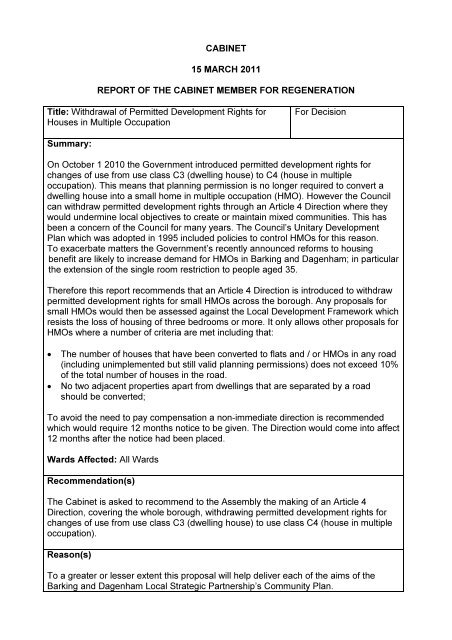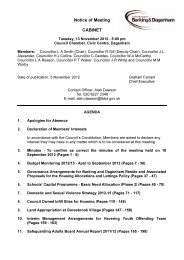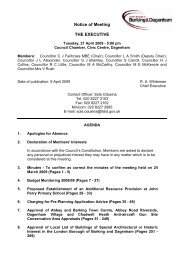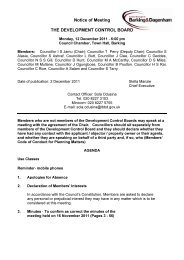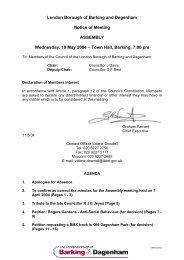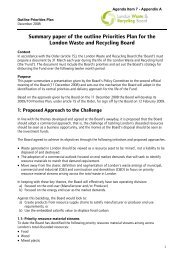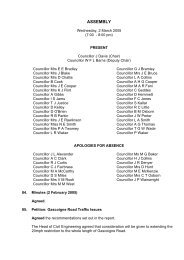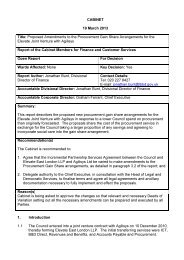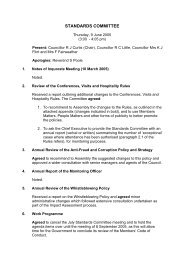Withdrawal of Permitted Development Rights for Houses
Withdrawal of Permitted Development Rights for Houses
Withdrawal of Permitted Development Rights for Houses
Create successful ePaper yourself
Turn your PDF publications into a flip-book with our unique Google optimized e-Paper software.
CABINET<br />
15 MARCH 2011<br />
REPORT OF THE CABINET MEMBER FOR REGENERATION<br />
Title: <strong>Withdrawal</strong> <strong>of</strong> <strong>Permitted</strong> <strong>Development</strong> <strong>Rights</strong> <strong>for</strong><br />
<strong>Houses</strong> in Multiple Occupation<br />
Summary:<br />
For Decision<br />
On October 1 2010 the Government introduced permitted development rights <strong>for</strong><br />
changes <strong>of</strong> use from use class C3 (dwelling house) to C4 (house in multiple<br />
occupation). This means that planning permission is no longer required to convert a<br />
dwelling house into a small home in multiple occupation (HMO). However the Council<br />
can withdraw permitted development rights through an Article 4 Direction where they<br />
would undermine local objectives to create or maintain mixed communities. This has<br />
been a concern <strong>of</strong> the Council <strong>for</strong> many years. The Council’s Unitary <strong>Development</strong><br />
Plan which was adopted in 1995 included policies to control HMOs <strong>for</strong> this reason.<br />
To exacerbate matters the Government’s recently announced re<strong>for</strong>ms to housing<br />
benefit are likely to increase demand <strong>for</strong> HMOs in Barking and Dagenham; in particular<br />
the extension <strong>of</strong> the single room restriction to people aged 35.<br />
There<strong>for</strong>e this report recommends that an Article 4 Direction is introduced to withdraw<br />
permitted development rights <strong>for</strong> small HMOs across the borough. Any proposals <strong>for</strong><br />
small HMOs would then be assessed against the Local <strong>Development</strong> Framework which<br />
resists the loss <strong>of</strong> housing <strong>of</strong> three bedrooms or more. It only allows other proposals <strong>for</strong><br />
HMOs where a number <strong>of</strong> criteria are met including that:<br />
• The number <strong>of</strong> houses that have been converted to flats and / or HMOs in any road<br />
(including unimplemented but still valid planning permissions) does not exceed 10%<br />
<strong>of</strong> the total number <strong>of</strong> houses in the road.<br />
• No two adjacent properties apart from dwellings that are separated by a road<br />
should be converted;<br />
To avoid the need to pay compensation a non-immediate direction is recommended<br />
which would require 12 months notice to be given. The Direction would come into affect<br />
12 months after the notice had been placed.<br />
Wards Affected: All Wards<br />
Recommendation(s)<br />
The Cabinet is asked to recommend to the Assembly the making <strong>of</strong> an Article 4<br />
Direction, covering the whole borough, withdrawing permitted development rights <strong>for</strong><br />
changes <strong>of</strong> use from use class C3 (dwelling house) to use class C4 (house in multiple<br />
occupation).<br />
Reason(s)<br />
To a greater or lesser extent this proposal will help deliver each <strong>of</strong> the aims <strong>of</strong> the<br />
Barking and Dagenham Local Strategic Partnership’s Community Plan.
Comments <strong>of</strong> the Chief Financial Officer<br />
This reports asks Members to agree to the introduction <strong>of</strong> an Article 4 Direction<br />
covering the whole Borough, in order to withdraw the development rights introduced by<br />
the Government in 2010 permitting a change in property class from that <strong>of</strong> ‘dwelling<br />
house’ to ‘house in multiple occupation’ (HMO’s). There<strong>for</strong>e any future proposals <strong>for</strong><br />
HMO’s would need to be assessed against the Council’s current Local <strong>Development</strong><br />
Framework, and satisfy certain criteria. However the Council would not be entitled to<br />
receive a fee <strong>for</strong> such planning applications that are only necessary because <strong>of</strong> an<br />
Article 4 Direction. In order to avoid any possible claims <strong>for</strong> compensation, the Council<br />
is to provide 12 months advance notice <strong>of</strong> the Article 4 taking effect (a non-immediate<br />
direction).<br />
The only costs to the Council associated with implementing the Article 4 Direction are<br />
the minor ones <strong>of</strong> publicising and printing (as well as staff time), which will be met from<br />
existing Regeneration & Economic <strong>Development</strong> budgets.<br />
Comments <strong>of</strong> the Legal Partner<br />
As a general principle developments require planning permission from the Council as<br />
the Local Planning Authority. To avoid every single development being referred to<br />
planning authorities; the Town and Country Planning (General <strong>Permitted</strong> <strong>Development</strong>)<br />
Order 1995 (the “Order”) gives the Secretary <strong>of</strong> State the power to issue directions that<br />
specified developments may be “permitted development” that is to say that they do not<br />
require planning consent.<br />
Article 4 <strong>of</strong> the Order provides that a local planning authority may resolve to withdraw a<br />
specific “permitted development” and instead require that development will still need to<br />
seek planning permission from the authority.<br />
Article 4 directions are one <strong>of</strong> the tools available to local planning authorities in<br />
responding to the particular needs <strong>of</strong> their areas. An article 4 direction does not prevent<br />
the development to which it applies, but instead requires that planning permission is<br />
first obtained from the local planning authority <strong>for</strong> that development.<br />
DCLG Guidance provides that Local planning authorities should consider making<br />
article 4 directions only in those exceptional circumstances where evidence suggests<br />
that the exercise <strong>of</strong> permitted development rights would harm local amenity or the<br />
proper planning <strong>of</strong> the area. For all article 4 directions the legal requirement is that the<br />
local planning authority is satisfied that it is expedient that development that would<br />
normally benefit from permitted development rights should not be carried out unless<br />
permission is granted <strong>for</strong> it on an application.<br />
In deciding whether an article 4 direction would be appropriate, local planning<br />
authorities should identify clearly the potential harm that the direction is intended to<br />
address.<br />
The Guidance also provides that in deciding whether an article 4 direction might be<br />
appropriate, local planning authorities may want to consider whether the exercise <strong>of</strong><br />
permitted development rights would <strong>for</strong> example, undermine local objectives to create<br />
or maintain mixed communities, or undermine the visual amenity <strong>of</strong> the area or damage<br />
the historic environment.
Provided there is justification <strong>for</strong> both its purpose and extent, it is possible to make an<br />
article 4 direction covering any geographic area from a specific site to a local authority<br />
wide. However, the Guidance also provides that there should be a particularly strong<br />
justification <strong>for</strong> the withdrawal <strong>of</strong> permitted development rights relating to a wide area<br />
e.g. those covering the entire area <strong>of</strong> a local planning authority.<br />
It should be noted that Article 4 directions cannot be used in relation to any type <strong>of</strong><br />
development other than those explicitly granted permitted development rights through<br />
the GPDO, nor can they be applied retrospectively to development undertaken be<strong>for</strong>e a<br />
direction comes into <strong>for</strong>ce, or to development that has been commenced at the time<br />
that a direction comes into <strong>for</strong>ce.<br />
Officers propose that the Council as Planning Authority should make an Article 4<br />
direction covering the whole borough, withdrawing permitted development rights <strong>for</strong><br />
changes <strong>of</strong> use from use class C3 (dwelling house) to use class C4 (house in multiple<br />
occupation). In making the direction Members should be satisfied that the legal<br />
provisions set out in this report and in the Government’s Guidance are met in this case.<br />
Head <strong>of</strong> Service:<br />
Jeremy Grint<br />
Cabinet Member:<br />
Councillor McCarthy<br />
Title:<br />
Divisional Director <strong>of</strong><br />
Regeneration and<br />
Economic <strong>Development</strong><br />
Portfolio:<br />
Regeneration<br />
1. The need <strong>for</strong> an Article 4 Direction<br />
Contact Details:<br />
Tel: 020 8227 2443<br />
E-mail: jeremy.grint@ltgdc.org.uk<br />
Contact Details:<br />
Tel: 020 8724 8013<br />
E-mail:<br />
(mick.mccarthy@lbbd.gov.uk)<br />
1.1 HMOs make an important contribution to the private rented sector by catering <strong>for</strong><br />
the housing needs <strong>of</strong> specific groups/households and by making a contribution to<br />
the overall provision <strong>of</strong> af<strong>for</strong>dable or private rented stock. However, HMOs are not<br />
without their problems. The 2008 report by CLG “Evidence Gathering – Housing in<br />
Multiple Occupation and possible planning responses” identified a number <strong>of</strong><br />
problems associated with HMOs including:<br />
• anti-social behaviour, noise and nuisance<br />
• imbalanced and unsustainable communities<br />
• negative impacts on the physical environment and streetscape<br />
• pressures upon parking provision<br />
• increased crime<br />
• growth in private rented sector at the expenses <strong>of</strong> owner-occupation<br />
• pressure upon local community facilities and<br />
• restructuring <strong>of</strong> retail, commercial services and recreational facilities to suit the<br />
lifestyles <strong>of</strong> the predominant population<br />
1.2 In response to this the previous Government introduced a new C4 use class <strong>for</strong><br />
small houses in multiple occupation and amended the 1995 (General <strong>Permitted</strong><br />
<strong>Development</strong>) Order so that planning permission was required to change between<br />
the C3 (dwelling house) and C4 (house in multiple occupation) use classes. The
new Government has reversed this decision. On the 1st October 2010 the Town<br />
and Country Planning (General <strong>Permitted</strong> <strong>Development</strong>) (Amendment) (No.2)<br />
(England) Order 2010 came into <strong>for</strong>ce. The Order amends the 1995 (General<br />
<strong>Permitted</strong> <strong>Development</strong>) Order and makes a change <strong>of</strong> use from a use falling within<br />
Class C3 (dwelling houses) to a use falling within Class C4 (houses in multiple<br />
occupation) ‘permitted development’ – i.e. planning permission is no longer needed<br />
to do this.<br />
1.3 The Government has presented this change as part <strong>of</strong> wider re<strong>for</strong>ms so that it<br />
moves from the current top down approach and creates a system which<br />
encourages local people to take responsibility <strong>for</strong> shaping their communities and<br />
gives power to Councils to make this happen.<br />
1.4 In this case the power is an Article 4 Direction. The Government has advised that<br />
local planning authorities should consider making Article 4 directions only in those<br />
exceptional circumstances where evidence suggests that the exercise <strong>of</strong> permitted<br />
development rights would harm local amenity or the proper planning <strong>of</strong> the area and<br />
that local planning authorities should identify clearly the potential harm that the<br />
direction is intended to address. The Government has advised that it might be<br />
appropriate to withdraw permitted development rights where they would undermine<br />
local objectives to create or maintain mixed communities. This has been a concern<br />
<strong>of</strong> the Council <strong>for</strong> many years. LBBD has had planning policies in place to control<br />
HMOs <strong>for</strong> at least 15 years. The previous Unitary <strong>Development</strong> Plan and the current<br />
Local <strong>Development</strong> Framework (LDF) seek to ensure that the number <strong>of</strong> houses<br />
that have been converted to flats and/or HMOs in any road does not exceed 10%.<br />
In addition the LDF now resists any proposals <strong>for</strong> residential conversions or Homes<br />
in Multiple Occupation which involve the loss <strong>of</strong> family sized houses. These policies<br />
were considered necessary to control the adverse effect that HMOs can have on<br />
the general character and amenity <strong>of</strong> an area and also to retain a reasonable stock<br />
<strong>of</strong> small/medium-sized dwellings suitable <strong>for</strong> families seeking to move out <strong>of</strong> flatted<br />
accommodation. The recent changes mean that the Council has no control over the<br />
loss <strong>of</strong> family sized houses to small HMOs nor can it restrict the number <strong>of</strong> small<br />
HMOs in any street.<br />
1.5 To exacerbate matters the Government’s recently announced re<strong>for</strong>ms to housing<br />
benefit are likely to increase demand <strong>for</strong> Homes in Multiple Occupation in Barking<br />
and Dagenham; in particular the extension <strong>of</strong> the single room restriction to people<br />
aged 35. This would mean that single childless adults would only be entitled to the<br />
equivalent <strong>of</strong> a room share rather than a self contained one bedroomed flat. This<br />
applies from April 2012 and existing claimants are affected when their claim is<br />
reviewed.<br />
1.6 There<strong>for</strong>e <strong>of</strong>ficers recommend that an Article 4 Direction is introduced to withdraw<br />
permitted development rights <strong>for</strong> small HMOs across the borough. This would mean<br />
that proposals to change a dwelling house into a HMO would require planning<br />
permission. Any such planning application would then be determined against Policy<br />
BC4 <strong>of</strong> the Council’s Local <strong>Development</strong> Framework. This policy resists proposals<br />
which involve the loss <strong>of</strong> housing <strong>of</strong> three bedrooms or more. It only allows other<br />
proposals <strong>for</strong> HMOs where a number <strong>of</strong> criteria are met including that:
• The number <strong>of</strong> houses that have been converted to flats and / or HMOs in any<br />
road (including unimplemented but still valid planning permissions) does not<br />
exceed 10% <strong>of</strong> the total number <strong>of</strong> houses in the road.<br />
• No two adjacent properties apart from dwellings that are separated by a road<br />
should be converted.<br />
This policy is scheduled to go to Assembly <strong>for</strong> adoption in March 2011.<br />
2 Process <strong>for</strong> making an Article 4 Direction<br />
2.1 The Government has recently published the Town and Country Planning<br />
(Compensation) (No. 3) (England) Regulations 2010 (2010 No. 2135). This reduces<br />
local authorities’ liability to pay compensation where they make article 4 directions<br />
as follows:<br />
• Where 12 months’ notice is given in advance <strong>of</strong> a direction taking effect there<br />
will be no liability to pay compensation; and<br />
• Where directions are made with immediate effect or less than 12 months’ notice,<br />
compensation will only be payable in relation to planning applications which are<br />
submitted within 12 months <strong>of</strong> the effective date <strong>of</strong> the direction and which are<br />
subsequently refused or where permission is granted subject to conditions.<br />
2.2 There<strong>for</strong>e to avoid potential compensation claims the Council needs to provide 12<br />
months notice in advance <strong>of</strong> an Article 4 Direction taking affect. This is called a nonimmediate<br />
direction.<br />
2.3 The procedure <strong>for</strong> making a “non-immediate” Article 4 Direction is as follows:<br />
• Give 12 months notice <strong>of</strong> direction<br />
• Seek representations<br />
• Assembly approval<br />
• Advertise direction and notify Secretary <strong>of</strong> State<br />
2.4 The Direction would come into affect 12 months after the notice had been placed.<br />
3. Financial Issues<br />
3.1 The Council does not receive a fee <strong>for</strong> planning applications which are only<br />
necessary because <strong>of</strong> an Article 4 Direction.<br />
3.2 To avoid potential compensation claims <strong>of</strong>ficers recommend that a non-immediate<br />
Article 4 direction is made.<br />
3.3 The minor costs <strong>of</strong> publicising and publishing the Article 4 Direction will be met from<br />
the Regeneration and Economic <strong>Development</strong> budget.<br />
4. Legal Issues<br />
4.1 On 1 October 2010 the Town and Country Planning (General <strong>Permitted</strong><br />
<strong>Development</strong>) (Amendment) (No.2) (England) Order 2010 came into <strong>for</strong>ce. The<br />
Order amends the 1995 (General <strong>Permitted</strong> <strong>Development</strong>) Order and makes a
change <strong>of</strong> use from a use falling within Class C3 (dwelling houses) to a use falling<br />
within Class C4 (houses in multiple occupation) ‘permitted development’ – i.e.<br />
planning permission is no longer needed to do this.<br />
4.2 Under Article 4 <strong>of</strong> the General <strong>Development</strong> Order (as amended) local planning<br />
authorities can make directions withdrawing permitted development rights from<br />
development listed in Schedule 2 <strong>of</strong> the same order. For all article 4 directions the<br />
legal requirement set out in paragraph (1) <strong>of</strong> article 4 <strong>of</strong> the GDO is that the local<br />
planning authority is satisfied that it is expedient that development that would<br />
normally benefit from permitted development rights should not be carried out unless<br />
permission is granted <strong>for</strong> it on an application. This report explains why it is<br />
expedient to withdraw permitted development rights <strong>for</strong> change <strong>of</strong> use from C3 to<br />
C4.<br />
4.3 The Local Authorities (Functions and Responsibilities) (England) Regulations 2000<br />
states that approval to make an Article 4 Direction is not a Cabinet function and<br />
there<strong>for</strong>e must be carried out by Assembly.<br />
5. Other Implications<br />
• Risk Management: Officers consider that there is a legally sound basis <strong>for</strong><br />
making this Article 4 direction. Whilst the Council has to notify the Secretary <strong>of</strong><br />
State when the direction is published it is unlikely he/she would intervene. Please<br />
see the options appraisal section <strong>for</strong> the risks associated with making immediate<br />
and non-immediate directions.<br />
• Contractual Issues: No specific implications.<br />
• Staffing Issues: No specific implications.<br />
• Customer Impact: HMOs make an important contribution to the private rented<br />
sector by catering <strong>for</strong> the housing needs <strong>of</strong> specific groups/households and by<br />
making a contribution to the overall provision <strong>of</strong> af<strong>for</strong>dable or private rented stock.<br />
Whilst black, Asian and other minority ethnic (BAME) communities are probably<br />
disproportionately represented in the HMO stock they are on balance likely to be<br />
advantaged by the Article 4 Direction <strong>for</strong> two reasons. BAME communities are<br />
more likely to require the family housing the Article 4 direction is seeking to<br />
protect and withdrawing permitted development rights will allow the Council more<br />
control over the location <strong>of</strong> small HMOs and there<strong>for</strong>e the associated problems<br />
cited earlier from the CLG Evidence Gathering report. This will be to the benefit <strong>of</strong><br />
all residents.<br />
• Safeguarding Children: Withdrawing permitted development rights will help<br />
preserve the borough’s stock <strong>of</strong> family housing. Many <strong>of</strong> the problems associated<br />
with HMOs cited in the CLG Evidence Gathering report will have an impact on the<br />
environment children are brought up in.<br />
• Health Issues: No specific implications<br />
• Crime and Disorder Issues: The CLG report cited earlier in this report identified<br />
that increased crime was a problem associated with HMOs. There<strong>for</strong>e<br />
withdrawing permitted development rights will help address this impact.
• Property/Asset Issues: No specific implications<br />
6. Options appraisal<br />
6.1 Failure to make this direction would leave the Council without the controls it has<br />
deployed <strong>for</strong> the last 15 years to manage the impact <strong>of</strong> small HMOs.<br />
6.2 For the reasons set out in the report <strong>of</strong>ficers consider that doing nothing is not an<br />
option.<br />
6.3 Making a non-immediate direction does mean that there is an intervening 12 month<br />
period when people can take advantage <strong>of</strong> the new permitted development rights.<br />
There may be a rush <strong>of</strong> HMOs in this period as people avoid the impending removal<br />
<strong>of</strong> permitted development rights. However as covered in the report an immediate<br />
direction would leave the Council open to compensation claims payable in relation<br />
to planning applications which are submitted within 12 months <strong>of</strong> the effective date<br />
<strong>of</strong> the direction and which are subsequently refused or where permission is granted<br />
subject to conditions.<br />
6.4 Compensation may be claimed <strong>for</strong> abortive expenditure or <strong>for</strong> other loss or damage<br />
directly attributable to the withdrawal <strong>of</strong> the permitted development rights. For<br />
example the Council could be liable <strong>for</strong> the loss <strong>of</strong> income a property owner suffers<br />
by not being able to convert their property to a HMO where this is due to the Article<br />
4 Direction. However an immediate direction may incentivise property owners to<br />
claim <strong>for</strong> compensation <strong>for</strong> HMO conversions they would not otherwise have carried<br />
out. This could leave the Council with a very significant liability. For this reason<br />
<strong>of</strong>ficers recommend that the non-immediate direction is the most appropriate course<br />
<strong>of</strong> action.<br />
7. Background Papers Used in the Preparation <strong>of</strong> the Report<br />
7.1 The following papers / reports were used in the preparation <strong>of</strong> this report:<br />
1. Evidence Gathering – Housing in Multiple Occupation and possible planning<br />
responses, CLG, 2008<br />
2. Town and Country Planning (General <strong>Permitted</strong> <strong>Development</strong>) (Amendment)<br />
(No.2) (England) Order 2010<br />
3. 1995 (General <strong>Permitted</strong> <strong>Development</strong>) Order (as amended)<br />
4. Town and Country Planning (Compensation) (No. 3) (England) Regulations 2010<br />
(2010 No. 2135).<br />
5. The Local Authorities (Functions and Responsibilities) (England) Regulations<br />
2000 (2000 No. 2853)<br />
6. Replacement Appendix D to Department <strong>of</strong> the Environment Circular 9/95:<br />
General <strong>Development</strong> Consolidation Order 1995<br />
7. Barking and Dagenham Unitary <strong>Development</strong> Plan, LBBD, 1995<br />
8. Barking and Dagenham Local <strong>Development</strong> Framework, post submission<br />
Borough Wide <strong>Development</strong> Policies, LBBD, 2010<br />
8. List <strong>of</strong> appendices<br />
None


